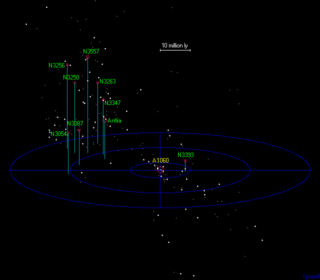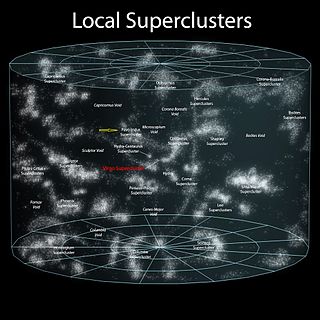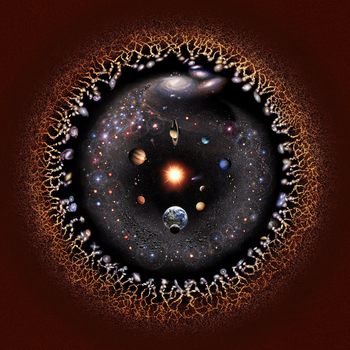
The Local Group is the galaxy group that includes the Milky Way. It has a total diameter of roughly 3 megaparsecs (10 million light-years; 9×1019 kilometres), and a total mass of the order of 2×1012 solar masses (4×1042 kg). It consists of two collections of galaxies in a "dumbbell" shape; the Milky Way and its satellites form one lobe, and the Andromeda Galaxy and its satellites constitute the other. The two collections are separated by about 800 kiloparsecs (3×10^6 ly; 2×1019 km) and are moving toward one another with a velocity of 123 km/s. The group itself is a part of the larger Virgo Supercluster, which may be a part of the Laniakea Supercluster. The exact number of galaxies in the Local Group is unknown as some are occluded by the Milky Way; however, at least 80 members are known, most of which are dwarf galaxies.

The IC 342/Maffei Group corresponds to one or two galaxy groups close to the Local Group. The member galaxies are mostly concentrated around either IC 342 or Maffei 1, which would be the brightest two galaxies in the group. The group is part of the Virgo Supercluster. However, recent studies have found that the two subgroups are unrelated; while the IC 342 group is the nearest galaxy group to the Milky Way, the Maffei 1 group is several times farther away, and is not gravitationally bound to the IC 342 group.

A supercluster is a large group of smaller galaxy clusters or galaxy groups; they are among the largest known structures in the universe. The Milky Way is part of the Local Group galaxy group, which in turn is part of the Virgo Supercluster, which is part of the Laniakea Supercluster, which is part of the Pisces–Cetus Supercluster Complex. The large size and low density of superclusters means that they, unlike clusters, expand with the Hubble expansion. The number of superclusters in the observable universe is estimated to be 10 million.
The following is a timeline of galaxies, clusters of galaxies, and large-scale structure of the universe.

The Virgo Supercluster or the Local Supercluster is a mass concentration of galaxies containing the Virgo Cluster and Local Group, which itself contains the Milky Way and Andromeda galaxies, as well as others. At least 100 galaxy groups and clusters are located within its diameter of 33 megaparsecs. The Virgo SC is one of about 10 million superclusters in the observable universe and is in the Pisces–Cetus Supercluster Complex, a galaxy filament.

The Great Attractor is a purported gravitational attraction in intergalactic space and the apparent central gravitational point of the Laniakea Supercluster of galaxies. This supercluster contains the Milky Way galaxy, as well as about 100,000 other galaxies.

The Hydra–Centaurus Supercluster, or the Hydra and Centaurus Superclusters, is a supercluster in two parts, the closest neighbour of Virgo Supercluster. It is located about 39 Mpc (127 Mly) away.

The Milky Way is the galaxy that includes the Solar System, with the name describing the galaxy's appearance from Earth: a hazy band of light seen in the night sky formed from stars that cannot be individually distinguished by the naked eye. The term Milky Way is a translation of the Latin via lactea, from the Greek γαλαξίας κύκλος, meaning "milky circle". From Earth, the Milky Way appears as a band because its disk-shaped structure is viewed from within. Galileo Galilei first resolved the band of light into individual stars with his telescope in 1610. Until the early 1920s, most astronomers thought that the Milky Way contained all the stars in the Universe. Following the 1920 Great Debate between the astronomers Harlow Shapley and Heber Doust Curtis, observations by Edwin Hubble showed that the Milky Way is just one of many galaxies.

The Horologium-Reticulum Supercluster, is a massive supercluster spanning around 550 million light-years. It has a mass of around 1017 solar masses, similar to that of the Laniakea Supercluster, which houses the Milky Way. It is centered on coordinates right ascension 03h 19m and declination −50° 02′, and spans an angular area of 12° × 12°.

The Pavo–Indus Supercluster is a neighboring supercluster located about 60–70 Mpc (196–228 Mly) away in the constellations of Pavo, Indus, and Telescopium. The supercluster contains three main clusters, Abell 3656, Abell 3698, and Abell 3742.

In cosmology, galaxy filaments are the largest known structures in the universe, consisting of walls of galactic superclusters. These massive, thread-like formations can commonly reach 50/h to 80/h Megaparsecs — with the largest found to date being the Hercules-Corona Borealis Great Wall at around 3 gigaparsecs (9.8 Gly) in length — and form the boundaries between voids. Due to the accelerating expansion of the universe, the individual clusters of gravitationally bound galaxies that make up galaxy filaments are moving away from each other at an accelerated rate; in the far future they will dissolve.
The Pisces–Cetus Supercluster Complex is a galaxy filament. It includes the Laniakea Supercluster which contains the Virgo Supercluster lobe which in turn contains the Local Group, the galaxy cluster that includes the Milky Way. This filament is adjacent to the Perseus–Pegasus Filament.

The Local Sheet in astronomy is a nearby extragalactic region of space where the Milky Way, the members of the Local Group and other galaxies share a similar peculiar velocity. This region lies within a radius of about 7 Mpc (23 Mly), 0.46 Mpc (1.5 Mly) thick, and galaxies beyond that distance show markedly different velocities. The Local Group has only a relatively small peculiar velocity of 66 km⋅s−1 with respect to the Local Sheet. Typical velocity dispersion of galaxies is only 40 km⋅s−1 in the radial direction. Nearly all nearby bright galaxies belong to the Local Sheet. The Local Sheet is part of the Local Volume and is in the Virgo Supercluster. The Local Sheet forms a wall of galaxies delineating one boundary of the Local Void.

The Laniakea Supercluster is the galaxy supercluster that is home to the Milky Way and approximately 100,000 other nearby galaxies.
The Taurus Void is a vast, near-empty region of space situated between the Perseus–Pisces Supercluster and the Virgo Supercluster. The Taurus void is unique because of its relatively close proximity to Earth, and because it helps to define the edge of latter's home supercluster, the Virgo Supercluster. Despite its close proximity to Earth, the Taurus Void is not well-studied because it is partially obscured by the Milky Way when viewed from Earth. In contrast to its ambiguous boundary in the section of sky obscured by the Milky Way, the Taurus Void has a very well-defined boundary with the Perseus-Pisces supercluster.

The Southern Supercluster is a nearby supercluster located around 19.5 Mpc (63.6 Mly) in the constellations of Cetus, Fornax, Eridanus, Horologium, and Dorado. It was first identified in 1953 by Gérard de Vaucouleurs.

Hélène Courtois is a French astrophysicist specialising in cosmography. She is a professor at the University of Lyon 1 and has been a chevalier of the Ordre des Palmes Académiques since 2015.
Daniel Pomarède is a staff scientist at the Institute of Research into the Fundamental Laws of the Universe, CEA Paris-Saclay University. He co-discovered Laniakea, our home supercluster of galaxies, and Ho'oleilana, a spherical shell-like structure 1 billion light-years in diameter found in the distribution of galaxies, possibly the remnant of a Baryon Acoustic Oscillation. Specialized in data visualization and cosmography, a branch of cosmology dedicated to mapping the Universe, he also co-authored the discoveries of the Dipole Repeller and of the Cold Spot Repeller, two large influential cosmic voids, and the discovery of the South Pole Wall, a large-scale structure located in the direction of the south celestial pole beyond the southern frontiers of Laniakea.
The Telescopium−Grus Cloud is a galaxy filament in the constellations of Pavo, Indus, and Telescopium. It was first defined by astronomer Brent Tully in his book The Nearby Galaxies Atlas and its companion book The Nearby Galaxies Catalog.








































